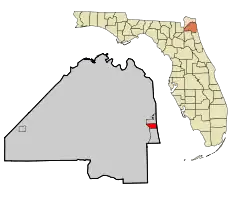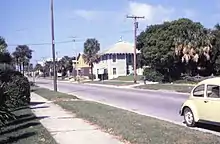Neptune Beach, Florida
Neptune Beach is a beachfront city east of Jacksonville in Duval County, Florida, United States. When the majority of Duval County communities consolidated with Jacksonville in 1968, Neptune Beach, along with Jacksonville Beach, Atlantic Beach and Baldwin remained quasi-independent. Like those other towns, it maintains its own municipal government but its residents vote in the Jacksonville mayoral election and are represented on the Jacksonville city council. With a 2020 census population of 7,217,[3] Neptune Beach is the smallest of the Jacksonville Beaches communities.
Neptune Beach, Florida | |
|---|---|
| City of Neptune Beach | |
 Images from top, left to right: Sunrise at the beach, City Hall, Beaches Town Center, Jaguar statue in the Beaches Town Center, Duncan U. Fletcher High School | |
 Location in Duval County and the state of Florida | |
| Coordinates: 30°19′00″N 81°24′11″W | |
| Country | United States |
| State | Florida |
| County | Duval |
| Area | |
| • Total | 6.85 sq mi (17.74 km2) |
| • Land | 2.34 sq mi (6.05 km2) |
| • Water | 4.51 sq mi (11.69 km2) |
| Elevation | 10 ft (3 m) |
| Population (2020) | |
| • Total | 7,217 |
| • Density | 3,088.15/sq mi (1,192.29/km2) |
| Time zone | UTC-5 (Eastern (EST)) |
| • Summer (DST) | UTC-4 (EDT) |
| ZIP code | 32266 |
| Area code | 904 |
| FIPS code | 12-48100 |
| GNIS feature ID | 0287587[2] |
| Website | City of Neptune Beach |
History

Neptune Beach was originally part of Jacksonville Beach. Through its development, the part of Jacksonville Beach north of 20th Avenue North was sparsely populated, with a brick road (First Street) connecting the more populated southern area with Atlantic Beach. The name "Neptune Beach" originated in 1922 with Dan G. Wheeler, one of the few residents. Wheeler had a home at what is now One Ocean Hotel (now in Atlantic Beach), and had to walk all the way home from Mayport each evening after taking the Florida East Coast Railway train home from work in Jacksonville. A friend who worked for the railroad informed Wheeler that if he had a station, the train would have to stop for him, so Wheeler built his own train station near his home and named it Neptune.
Neptune seceded from Jacksonville Beach and incorporated as its own municipality in 1931, following a tax revolt. The comparatively few residents of the area were largely cut off from Jacksonville Beach city services such as police, fire, garbage collection, and road developments, though they paid taxes in equal share. The first mayor was O. O. McCollum, and the government met in Wheeler's old train station until a new town hall was completed in 1935.
Geography
Neptune Beach is located at 30°19′00″N 81°24′11″W (30.316641, –81.403081).[4]
Neptune Beach is one of several towns on San Pablo Island, which stretches through two counties (Duval and St. Johns) and extends from Naval Station Mayport at its northern tip to Vilano Beach in the south, across from St. Augustine.
According to the United States Census Bureau, Neptune Beach has a total area of 6.8 square miles (17.7 km2), of which 2.3 square miles (6.0 km2) is land and 4.5 square miles (11.7 km2) (65.96%) is water.[3]
Demographics
| Census | Pop. | Note | %± |
|---|---|---|---|
| 1940 | 1,363 | — | |
| 1950 | 1,767 | 29.6% | |
| 1960 | 2,868 | 62.3% | |
| 1970 | 4,281 | 49.3% | |
| 1980 | 5,248 | 22.6% | |
| 1990 | 6,816 | 29.9% | |
| 2000 | 7,270 | 6.7% | |
| 2010 | 7,037 | −3.2% | |
| 2020 | 7,217 | 2.6% | |
| U.S. Decennial Census[5] | |||
As of the census of 2010, there were 7,037 people, 3,282 households, and 1,857 families residing in the city. The population density was 2,968.8 inhabitants per square mile (1,146.3/km2). There were 3,472 housing units at an average density of 1,417.9 per square mile (547.5/km2). The racial makeup of the city was 96.08% White, 0.73% African American, 0.40% Native American, 1.03% Asian, 0.06% Pacific Islander, 0.52% from other races, and 1.18% from two or more races. Hispanic or Latino of any race were 2.09% of the population.
There were 3,282 households, out of which 24.2% had children under the age of 18 living with them, 44.9% were married couples living together, 8.2% had a female householder with no husband present, and 43.4% were non-families. 31.3% of all households were made up of individuals, and 7.7% had someone living alone who was 65 years of age or older. The average household size was 2.22 and the average family size was 2.85.
In the city, the population was spread out, with 19.3% under the age of 18, 8.4% from 18 to 24, 33.3% from 25 to 44, 26.9% from 45 to 64, and 12.1% who were 65 years of age or older. The median age was 39 years. For every 100 females, there were 103.8 males. For every 100 females age 18 and over, there were 99.7 males.
The median income for a household in the city was $53,576, and the median income for a family was $65,684. Males had a median income of $43,431 versus $30,264 for females. The per capita income for the city was $30,525. About 1.9% of families and 2.5% of the population were below the poverty line, including 1.8% of those under age 18 and 2.9% of those age 65 or over.
Education
Duval County Public Schools operates public schools. Schools in Neptune Beach include:
- Neptune Beach Elementary School
- Duncan U. Fletcher Middle School
- Duncan U. Fletcher High School
Jacksonville Public Library operates the Beaches Branch in Neptune Beach.
Gallery
 Neptune Beach City Hall
Neptune Beach City Hall Duncan U. Fletcher Middle School
Duncan U. Fletcher Middle School Neptune Beach Elementary School
Neptune Beach Elementary School Beaches Branch Library, Jacksonville Public Library
Beaches Branch Library, Jacksonville Public Library Public Safety Building (Police Headquarters)
Public Safety Building (Police Headquarters).jpg.webp) Beaches Town Center Entrance at Neptune Beach Boundary
Beaches Town Center Entrance at Neptune Beach Boundary Typical Dune Crossover at Beach Accesses in Neptune Beach
Typical Dune Crossover at Beach Accesses in Neptune Beach
See also
References
- "2020 U.S. Gazetteer Files". United States Census Bureau. Retrieved October 31, 2021.
- U.S. Geological Survey Geographic Names Information System: Neptune Beach, Florida
- "Geographic Identifiers: 2010 Demographic Profile Data (DP-1): Neptune Beach city, Florida". U.S. Census Bureau, American Factfinder. Archived from the original on February 12, 2020. Retrieved March 25, 2013.
- "US Gazetteer files: 2010, 2000, and 1990". United States Census Bureau. February 12, 2011. Retrieved April 23, 2011.
- "Census of Population and Housing". Census.gov. Retrieved June 4, 2015.
External links
- Official website
 Geographic data related to Neptune Beach, Florida at OpenStreetMap
Geographic data related to Neptune Beach, Florida at OpenStreetMap

